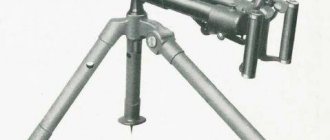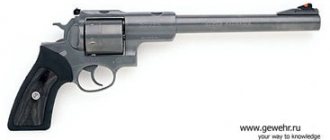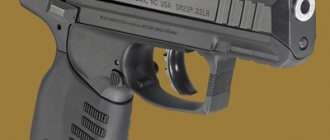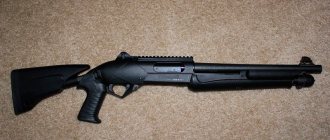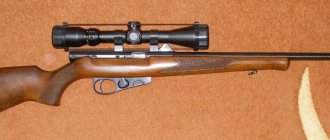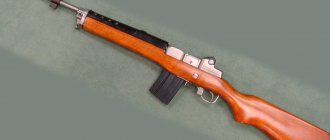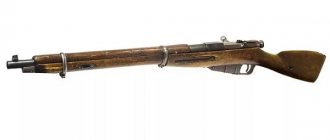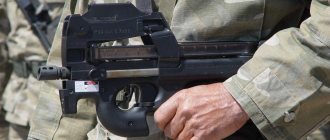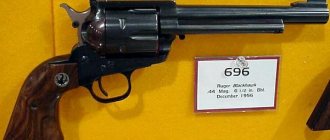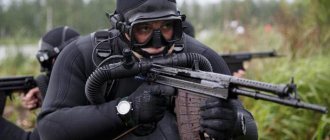"10/22" redirects here. For the date, see 22 of October .
Type of self-loading rifle Rimfire
| Ruger 10/22 | |
| Ruger 10/22 | |
| Type | Self-loading rimfire rifle |
| Place of origin | United States |
| Service history | |
| Used | See Users |
| Wars | Israeli-Palestinian conflict [1] |
| Production history | |
| Designer | William B. Ruger, Harry H. Sefried II [2] [3] |
| Developed | 1964 [4] |
| Manufacturer | Sturm, Ruger & Co. |
| Unit cost | 54,50 $ (1965) [5] |
| Produced | 1964–present |
| No built | over 7 million (2015) [3] |
| Options | 10/22 Carbine 10/22 Takedown 22 Charger Pistol 10/22 Magnum 10/17 SR-22 |
| Technical specifications (Standard 10/22 carabiner) | |
| Weight | 5 lb (2.3 kg) [5] |
| Length | 37 inches (940 mm) [5] |
| Barrel length | 18.5 inches (470 mm) [5] |
| Cartridge | .22 Long Rifle [5] .22 Magnum (10/22 Magnum only) .17 HMR (10/17 only) |
| Action | Semi-automatic |
| Feeding system | 10-round rotary magazine or 25- and 15-round box magazine |
Ruger 10/22
is a series of semi-automatic rifles produced by the American firearms manufacturer Sturm, Ruger & Co. , chambered for the .22 Long Rifle rimfire cartridge. It uses a proprietary 10-round rotary magazine, although larger capacity box magazines are also available. The standard carbine version of the Ruger 10/22 has been in production continuously since 1964, [6] making it one of the most successful rimfire rifle designs in history, with numerous third-party manufacturers making parts and accessories for upgrades and customization. In fact, the 10/22 aftermarket is so rich that a 10/22 can be built from non-Ruger components.
Magnum 10/22 version known as 10/22 Magnum
, chambered for .22 WMR, produced from 1998 to 2006.
A .17 HMR version, 10/17
, was announced in 2004 [7] but was cataloged for only two years. [8]
CONTENT
- 1 Use and setup
- 2 Variations 2.1 10/22 Carbine 2.1.1 Target 10/22
- 2.1.2 10/22 Target Lite
- 2.1.3 10/22 Compact
- 2.1.4 10/22 Sporter
- 2.1.5 10/22 Tactical
- 2.1.6 Competition October 22
- 2.1.7 50th Anniversary Rifle
- 2.1.8 Collector's Series
- 2.1.9 Collector's Series, Second Edition
- 2.1.10 VLEH Target Tactical Rifle
- 2.2.1 10/22 Takedown Lite
- 3.1 AWC Ultra II
- 4.1 AMT Lightning 25/22
Use and configuration [edit]
The Ruger 10/22 is fully customized by Clark Custom Guns. Clear/Red Magazines - 40th Anniversary Edition.
Ruger 10/22 Custom with Butler Creek folding stock and Millett DMS-1 1-4 X 24mm scope
10/22 immediately became popular upon its release. It was designed to be a quality adult shotgun with adult ergonomics, rather than a stereotypically cheap "youth rifle". It was styled to resemble a US 30 caliber M1 carbine, which added to its appeal. Its ease of handling, low recoil and inexpensive ammunition nevertheless make it ideal for young or inexperienced shooters. It is very popular among small game hunters and those who want an inexpensive gun to shoot inexpensive ammo for target and plink shooting. [9] This popularity led to many aftermarket modifications to improve performance, improve the appearance of the rifle, or increase magazine capacity, making the 10/22 one of the most customizable firearms ever created. [10] [11] Custom manufacturers also make 10/22 "clones" that are similar in design (most parts are interchangeable) but built to much higher performance and cost. The 10/22 barrel uses a unique two-screw V-block system to secure the barrel to the receiver, making it easy to remove and replace the barrel (which would require gunsmith work on most other rifles). [3] Combined with the simple design of the remaining components, this means that the average person can easily replace any part of the gun using only a screwdriver, an allen key, and simple punches.
Ruger 10/22 "Stainless" with Butler Creek folding stock and TRUGLO Red Dot sight.
A class higher. Ruger Mark IV Sporting Pistol
The Standard rimfire pistol began the rise of Sturm, Ruger & Co. in 1949. Ruger is now introducing a new version of the MK IV, which we tested in sport trim. With the newest generation, Ruger has made significant improvements over its predecessors.
William Ruger, born June 21, 1916, was interested in mechanics and weapons from an early age. Therefore, it is not surprising that soon after graduating from high school, his professional path led him to the firearms industry. During World War II, he worked for Auto-Ordnance, which was founded in 1916 by former officer and weapons designer John T. Thompson.
In the late 1930s, William Ruger began designing weapons. After World War II, the arms industry slowly began to restructure itself into the production of civilian weapons. Ruger designed a simple, reliable, and at the same time very accurate shooting small-caliber pistol, which, however, none of the major weapons manufacturers wanted to put into mass production. At that time, the Colt Woodsman and High Standard models dominated the .22 lr self-loading pistol market in North America.
In 1949, Bill Ruger, in the person of Aleksander Sturm, found a partner who invested the necessary capital to found his own company. In modest circumstances, Sturm, Ruger & Co. in Southport, Connecticut, began production of a small-bore pistol designed by Ruger. Today we know that this began the rise of the company, which has become one of the most significant in the mass production of weapons. At first the production program included a so-called "standard" model with a 4 3/4 inch (121 mm) barrel and a non-adjustable sight. Ruger's design was noticeably different in shape from those of its main competitors, High Standard and Colt.
And the MK IV variant retains the classic appearance of previous generations.
New ways
Instead of a conventional Ruger pistol bolt, the cylindrical bolt is guided in a round bolt box with a barrel mounted at the front end. Like all subsequent modifications, the Ruger Standard pistol uses the recoil energy of a free bolt, which does not have a rigid connection with the barrel at the moment of firing and is pressed to the breech end of the barrel by the force of the return spring. At the end of the cylindrical bolt there is a transversely located element for gripping, by which the bolt is pulled when loading.
Like all rimfire pistols, the Ruger MK IV has a simple inertia action. The grip element is located at the rear of the bolt
Top view of the frame. There is a stopper at the rear and a trigger in front of it. There is a hinge bolt in front around which the top rotates
It was followed by the following variants, in particular, a version with a 6-inch (152 mm) barrel. With the Target variant, which had an adjustable sight, the designation MK I appeared in 1951. For the MK I, not only the barrel contour and sight were changed, but also the trigger mechanism was improved. Otherwise, MK I corresponds to the Standard modification. The original version features the famous red eagle logo on the left cheek of the handle. In 1951, after the tragic death of the company's founder, Alexander Sturm, the red eagle was made black as a sign of mourning.
Very quickly after its introduction, the Ruger pistol became a “best seller.” Among other things, this was facilitated by a very early positive review that appeared in the November issue of American Rifleman magazine. The author of that article was legendary weapons expert Julian S. Hatcher.
Already in 1979, the number of produced pistols of the first generation (Standard and MK I) reached a million. The pistol, with serial number 1,000,000, was richly engraved.
MK II: Changing of the Guard
At the end of 1981, the number of pistols produced reached 1,250,000. In 1982, a redesigned version of the MK II entered the market. From this point on, all models began to be designated MK II. For the MK II, a shutter stop located on the left was introduced. On the rear of the bolt box, bevels were made on the sides to provide a comfortable grip on the rear of the bolt. In addition, the nine-round magazine of the first generation in the MK II became a ten-round magazine.
In 1993, the 22/45 version, equipped with a plastic frame, entered the market. The next revision occurred in 2005, the MK III series appeared. Along with minor technical changes, the most significant for the MK III series was the movement of the magazine latch from below to the trigger guard, behind it. Production of this series continued until 2016.
A new era begins
Since 2022, there has been a MK IV version, which is a thorough revision of the MK III variant. One could say that the MK IV reached the limit of perfection for the Ruger .22 caliber pistol.
From Heinz Henke we received the Target variant with a heavy 5 1/2 inch (140 mm) match barrel. While the version we tested has an oxide finish and a light alloy frame, the Stainless version has a stainless steel frame. In addition, there is also the MK IV Hunter version made entirely of stainless steel and the MK IV 22/45 Lite with a plastic frame.
The Target variant of the Ruger MK IV features a heavy 5 1/2-inch (140 mm) barrel and adjustable sporting sights.
The significant improvement in the new MK IV is evident during disassembly. If the pistols of the first three generations had a stopper pulled out to separate the mainspring casing, then this element is absent in the MK IV. On the front of the frame the MK IV has a pivot bolt around which the top swings.
After rotating the top part, the bolt can be removed back from the round casing. The solution has been developed again
To do this, separate the magazine, cock the pistol and turn on the safety. On the back side, at the bottom of the shutter, there is a button that you simply press, and at the same time the upper part can be rotated down. The bolt can be removed back from the bolt box. In this case, the vertically located rod that limits the shutter rollback remains in the frame. In previous versions it was removed. By rotating downwards, the top of the gun can be completely separated from the frame. Thanks to the new disassembly scheme, the usual baggyness when assembling the pistol, which was common in previous versions, was eliminated.
A Ruger MK IV Target pistol disassembled into its main parts. The magazine holds ten rounds of .22 lr rounds
The next major upgrade for the MK IV is the fuse design. The previous slide safety has been replaced by a double-sided safety lever, which is well designed ergonomically. When the safety lever is turned down, the weapon is ready to fire. In the upper, horizontal position, the fuse is on. The safety locks the trigger. When the safety is on, the shutter can move.
The Ruger MK IV Target pistol has a cylindrical recess at the muzzle of the barrel, which reliably protects sensitive rifling from damage. The outer edge of the muzzle is carefully chamfered. The Ruger MK IV pistol has an ambidextrous safety located at the top of the frame.
After the last shot, the MK IV's bolt remains open. The shutter stop lever is located on the left side of the frame. The magazine release button is located on the left behind the trigger guard. The single-stack magazine holds ten rounds of .22 lr rounds and is easy to load. With a little practice, the gear doesn't end with bloody fingers.
The trigger mechanism of the tested weapon was well adjusted and worked after overcoming a force of 1.9 kg. For a beginner's weapon in this price category, it is quite satisfactory and also acceptable for sport shooting, not to mention the favorite “plinking” (recreational shooting) in the USA. But still, shooting practice shows that such a trigger has little in common with the match trigger of the Walther GSP model. The existing magazine fuse turns out to be redundant.
The grip cheeks of the MK IV Target are made of black plastic; their surface is completely covered with corrugation. They are fixed to the frame with two screws each. The company logo is applied on both cheeks. The front and back surfaces of the frame are left smooth.
The cylindrical match barrel has an outer diameter of 22.1mm, giving the aluminum framed MK IV Target a very desirable slight balance bias towards the muzzle. The muzzle of the barrel is equipped with a cylindrical recess, which protects sensitive rifling from damage. The outer edge of the muzzle is chamfered.
A scope suitable for sport shooting
The open sight consists of a rear sight that is adjustable vertically and horizontally using a screwdriver and has a 3.2 mm wide slot. The rectangular front sight, sitting on the base, has a width of 3.1 mm. Thanks to the matte black surface, the resulting image of the front sight and slot has good contrast and is optimal for target shooting. On the upper surface of the bolt box there are threaded holes for installing a base for mounting a sight, equipped with plug screws. Thanks to this, the MK IV can be equipped with optical sights without great expense.
On the front sight base screwed to the barrel there is a rectangular front sight suitable for sport shooting, which provides good contrast. The rear sight is adjustable vertically and horizontally using a screwdriver, as it should be for a sports pistol
The MK IV Target comes in a cardboard box complete with a spare magazine, trigger guard lock and instruction manual. The workmanship is up to the usual Ruger standards.
Fun at the shooting range
We tested the Ruger MK IV Target with ten of the most common cartridge options. Options were presented from Subsonic (subsonic) to HV (high-speed) of all conventional classes in terms of accuracy of fire. Shooting was carried out at the usual distance of 25 m, positioning - sitting from a rest; in this case, of course, the results were also influenced by scattering depending on the shooter. It is known that .22 caliber self-loading pistols with different cartridges shoot somewhat differently and function differently well. But the Ruger MK IV Target pistol is flawless in this regard. With all the cartridges given in the review, the pistol fired without delay. Only with Remington's Subsonic ammo did the bolt sometimes fail to stop after the last shot. With Subsonic cartridges, as well as all standard variants, all ten shots could be held in the “ten” of the German Rifle Association pistol target (50 mm diameter). Only with Winchester Laser cartridges, as well as Remington HV, individual shots hit the “nine” and increased the dispersion diameter to 63 mm. But with CCI Mini Mag cartridges you can keep hits within the “ten” range. With RUAG Eley Match Pistol cartridges of both types, as well as Winchester T 22, dispersion diameters from 30 to 40 mm were reproduced repeatedly.
With such shooting accuracy, the Ruger MK IV is also suitable for serious competition. But in any case, the force of descent requires special concentration and training.
The cost of the pistol indicates an extremely favorable price-quality ratio. On the German market, the MK IV Target meets the requirements of novice pistol athletes looking for a solution for little money. Among lower to intermediate shooters, the MK IV can be used exceptionally well in competition. In its homeland of the United States, the MK IV, like its predecessors, dominates the plinking pistol market. Today, from a German point of view, this segment is ridiculously small, but in the US there are billions of dollars in circulation.
DWJ findings
Ruger has made important changes to the MK IV compared to previous generations. In particular, these include simplifying incomplete disassembly. It can be done without tools. A micrometer sight and a heavy 5 1/2-inch (140 mm) barrel are practically justified for sport shooting. Key features of the new Ruger MK IV include reliable performance in a variety of .22 lr cartridge options ranging from low-velocity Subsonic to HV (High Velocity).
Hans J. Heigel, translation by Mikhail Dragunov
Options [edit]
Ruger 10/22 International model with full Mannlicher style stock.
The 10/22 is available in a wide variety of configurations. In 2015, the Ruger 10/22 was available in 11 different models, not counting exclusive distributors. The carbine was produced in three models; Tactical, Takedown and Target each had two models; the Sporter and Compact each had one model. Discontinued 10/22 International
The model was equipped with a Mannlicher warehouse.
Standard barrel length is 20" in the 10/22 rifle
, 18 1/2" in the
10/22 carbine
, and 16 1/8" in the
10/22 Compact rifle
, which is also equipped with a shorter stock. All .22 Long Rifle versions use an aluminum receiver, while the discontinued .22 Magnum version used a steel receiver with integral sight bases.
10/22 Carbine [edit]
Standard model with 18.5" barrel. Available with a hardwood or black synthetic barrel, black alloy or stainless steel receivers, and a model equipped with a LaserMax laser sight.
10/22 Target[edit]
Model for target shooting with a heavy 20-inch barrel without a scope. [12]
10/22 Target Lite [edit]
Introduced in 2022, the Target Lite is similar to the Target model but with a laminate thumbhole stock.
10/22 Compact[edit]
Compact rifle with a 16.12 inch barrel.
October 22 Sporter[edit]
Model with 18.5-inch, alternative 20-inch or 22-inch barrel and checkered walnut stock with sling swivels.
10/22 Tactical[edit]
Model with 16.12-inch flash suppressor. Also available with a 16.12-inch heavy target barrel with a Hogue OverMolded stock equipped with a bipod.
Competition October 22[edit]
The 10/22 Competition rifle features an anodized, CNC-machined, heat-treated 6061-T6511 stress-free aluminum receiver. The receiver includes a rear cleaning port and an integrated 30 MOA Picatinny rail for optics. The rifle also features an improved semi-auto chamber, BX trigger, heat-treated and nitrided CNC machined match bolt, free-floating 16-1/8" cold forged barrel with flutes for reduced weight and heat dissipation and Features 1/2"-28" threads to accommodate the included muzzle brake or other barrel accessories. [13]
50th Anniversary Rifle[edit]
In 2014, to commemorate the 50th anniversary of the Ruger 10/22, a competition was held to design a commemorative model. The winning design by public vote features an 18.5-inch threaded stainless steel barrel with a flash hider, a lightweight black synthetic stock with interchangeable stock modules, a Picatinny rail and an adjustable rear sight with a prism ring.
Collector's Series[edit]
In 2014, a limited edition 50th Anniversary Collector's Series Carbine was offered. It had a black alloy receiver with special "1964-2014" markings, an 18.5-inch barrel, fiber optic sights and a 25-round magazine.
Collector's Series, Second Edition[edit]
In June 2015, Ruger announced a limited second edition of the Collector's Series 10/22 carbine. It features a dark gray version of the Ruger modular stock system found on the Ruger American Rimfire, a protected, anti-glare front sight, variable aperture rear sight, and Picatinny rail. [14]
VLEH Target Tactical Rifle[edit]
In 2009, Ruger also announced the Target Tactical Rifle
, a hybrid 10/22T and Ruger M77 Hawkeye Tactical.
[15] V
Varmint
barrel ,
L
-
Law
+
E
Enforcement
model ,
H
-
Hogue
.
Murder of October 22[edit]
On March 28, 2012, Ruger introduced the 10/22 Takedown model. [16] This model can be easily disassembled into barrel and bolt/breech components. It comes in a backpack that has space for the rifle, ammo, and accessories. Manufacturer's suggested retail price is higher than basic carabiner models. [17] [18] The standard Takedown model features a brushed aluminum receiver reminiscent of stainless steel and an 18.5-inch barrel with a black synthetic stock. Also offered is a black alloy receiver and a 16.12-inch threaded barrel with flash hider or threaded. The target barrel is grooved.
10/22 Takedown Lite [edit]
Takedown Lite models are similar to other Takedown models, but have a lighter target barrel design.
SR-22 rifle[edit]
In 2009, Ruger released the SR-22 rifle
, a 10/22 receiver built into a chassis that mimics the dimensions of an AR-15 style rifle like their own SR-556. The SR-22 rifle uses standard 10/22 rotary magazines in addition to most aftermarket 10/22 magazines. [19] The magazine release, safety, and charging handle positions are more similar to a standard 10/22 than an AR-15. The SR-22 competes directly with other AR-15 style rimfire rifles such as those made by Colt and Smith & Wesson. The SR-22 features an aluminum handguard, a six-position adjustable stock, and an upper receiver rib. Threaded holes on the forend allow for additional mounting guides.
22 loading pistol [edit]
Ruger charger. Comes with bipod. Shown with aftermarket Truglo multi-color reflex dot sight and Ruger BX-25 extended magazine.
22 Charger
the pistol, first introduced in late 2007, is a 10/22 action pistol. The 22 Charger originally came with a black laminated wood pistol with a stock handguard, a 10-inch (254 mm) matte blued heavy cylinder, a bipod, and a base type Weaver scope in place of iron sights. The overall length is just under 20 inches (510 mm), making it quite large for a pistol. Since the kit includes a bipod, it can likely be used from a shooting bench or table. The bipod is attached to the swivel on the forend of the butt and is easily removed. Due to technical features, such as the magazine being located outside the pistol grip, the charger is not officially available in some US states. The 22 Charger was later discontinued. [20][21] It was reintroduced in December 2014 with a brown laminate stock with an M16A2-style pistol grip, a 10-inch threaded barrel, a Picatinny rail, a 15-round magazine, and an adjustable bipod. At the same time, the Takedown model was introduced with a green laminate. Both models were later offered in September 2015 with black polymer stocks.
10/22 Magnum[edit]
The 10/22 Magnum was produced from 1998 to 2006 and was chambered in .22 Magnum. [22]
October 17[edit]
The 10/17 cartridge was announced in 2004 and was designed to chamber the .17 HMR cartridge.
Ruger Precision Rifle
The Ruger company from the American city of Southport (Connecticut) is the fourth largest arms company in the United States. Founded in 1949, the company has been pleasing its consumers for more than seventy years, offering reliable and high-quality firearms to the market. In total, the company has more than 40 weapon models and approximately 700 modifications in its arsenal. All Ruger small arms are in demand in the US civilian market, as well as among professional shooting sportsmen. The undoubted success of the company in recent years has been the high-precision rifle Ruger Precision Rifle (RPR), the first generation of which was first demonstrated in 2015.
Accurate and affordable rifle
Americans know how to count money, which is why many citizens who are interested in precision or sports shooting choose the Ruger Precision rifle.
This model is an economical option for anyone who is going to develop their hobby. Most Ruger Precision models on the US market today start at a suggested retail price of $1,599. For a high-precision model that is well suited for long-range shooting, this is a small price to pay. The rifle is perfect for both beginners and those who have already plunged into the world of precision shooting. This is not surprising when you consider that trained shooters, when using high-quality ammunition of various calibers, can achieve accuracy from 0.5 to 1 MOA when shooting at 100 yards (91.44 meters). Today, Ruger's products are to the firearms market what Ford's products are to the passenger car market. The company's line includes very successful models, which include the Mini-14 semi-automatic rifle, the Hawkeye hunting rifle or the GP100 revolver. The Ruger Precision line of high-precision shotguns has not been lost in this company, becoming a real hallmark of the brand in recent years.
The Ruger Precision Rifle (RPR) was first introduced to the public back in 2015 at the SHOT Show. Over the past five years, the model has managed to earn the love of many shooters and is actively sold on the market, being one of the best examples of small arms from Sturm, Ruger & Co, which everyone is accustomed to simply calling Ruger. Already on May 6, 2016, an updated version of the rifle was presented, designated Ruger Precision “Gen 2”. Among other things, the rifle received a new handguard, a hybrid muzzle brake and an aluminum bolt casing.
The rifle was initially shown to the public in three main calibers. The popular .308 Win (aka 7.62x51 mm NATO) and two less common ones: 6.5 Creedmoor (6.5x48 mm) and .243 Winchester (6x52 mm). Quite quickly, Ruger specialists expanded the line of available calibers and barrels. Today, the market also offers high-precision Ruger Precision rifles chambered for the following cartridges: 6 mm Creedmoor and .300 Win Mag (7.62x67 mm). The most powerful option available is the model chambered for .338 Lapua Magnum (8.6x70 mm). Using the latest ammunition, a trained shooter is able to hit growth targets at distances of up to 2000 meters, although the most effective firing range for all presented ammunition is distances from 1000 to 1500 meters. Rifles chambered for .300 Win Mag and .338 Lapua Magnum are more expensive, with prices starting at $2,099 today.
Technical features of the Ruger Precision rifle
The Ruger Precision rifle is suitable for sport shooting, hunting, and home defense.
At the same time, the model is a truly high-precision weapon. The model is a classic store-bought “swamp gun”. The Ruger Precision rifle received a longitudinally sliding bolt with three stops. An interesting fact that directly affected the price of the model is that the entire bolt group was taken from the American Rifle carbine, which Ruger has produced since 2012. This made the cost of the new product very attractive. Since the bolt group was originally designed taking into account mass and relatively inexpensive production on modern CNC machines. At the same time, the bolt group remained just as reliable, massive and without any serious restrictions in use. A special feature of the rifle is that it can be adjusted as flexibly as possible to the various anthropometric data of its owner. At the same time, many shooters will like the fact that the model is built on an AR-like platform that is familiar to many generations of Americans. Despite the choice of a classic platform, the weapon has a number of its own technical features. Among them, experts highlight a centered chamber, a minimum distance from the barrel to the chamber, and the minimum dimensions of the rifling of the barrel bore. Due to the linear recoil from the receiver to the rubber recoil pad of the adjustable stock, the rifle's designers did not use a frame design or bedding.
The existing Ruger Precision rifle design provides very high accuracy and good controllability of the model. Moreover, all second-generation rifles, which are presented in stores today, are initially equipped with a Ruger Hybrid muzzle brake, which also makes shooting more comfortable in any conditions. The muzzle brake reduces recoil, flash size and noise levels.
All Ruger Precision rifles are equipped with match free-floating barrels, which are cold forged from special high-strength chrome-molybdenum steel. Depending on the caliber of the shooter, models with different barrel lengths are available. For 7.62 mm rifles - this is 20 inches (508 mm), for models chambered for 6 mm Creedmoor, 6.5 Creedmoor and 300 Win Mag - this is 24 inches (610 mm), for a rifle chambered for .338 Lapua Mag - it is 26 inches (660 mm). All barrels received 5R rifling. They have five grooves, the edges of which form not straight, but obtuse angles with the surface of the barrel bore. This technical solution of the rifle developers is aimed at increasing shooting accuracy and reducing barrel wear. The maximum length of a rifle with a 26-inch barrel is 1333.5 mm with the butt extended to its maximum length, with the butt folded - 1025 mm. Model weight – 6.9 kg. Rifles chambered for the 7.62 mm cartridge with a 20-inch barrel are significantly lighter - up to 4.44 kg.
In designing the new rifle's trigger, Ruger engineers also looked to their American Rifle hunting rifle. The Ruger Precision precision rifle has an adjustable trigger mechanism, which features a weapon safety plate located longitudinally in the middle part of the trigger and protruding from it. The shooter can press the trigger only after he has first completely recessed this plate. Each rifle owner can adjust the trigger force in a suitable range from 1 to 2.2 kg.
The upper receiver of all models is made of high-strength steel. The connecting lower part is made of high-strength lightweight aluminum alloy with a magazine receiver, trigger guard and ergonomic AR-family pistol grip. A full-size Picatinny-type rail runs along the entire upper part of the receiver, which allows you to install any sighting devices on the weapon. The model is equipped with a folding adjustable buttstock. The range of adjustments is quite wide, while the butt cheek is adjustable in height, and the length of the butt can be changed within a range of 90 mm.
All rifles are equipped with box magazines capable of holding 10 rounds. The rifle comes with two such magazines. The exception is the model chambered for .338 Lapua Mag, here shooters have access to only 5-round magazines. The designers have placed the magazine release in front of the magazine receiver, which makes pressing it quite convenient. On the left side of the Ruger Precision rifle's receiver is a two-position rotary safety, located directly above the pistol grip.
Traditionally, the cost of joining the precision shooting club has been high. Weapons were quite expensive, and shooting at long distances with cheap rifles was ineffective. To confidently hit targets at a distance of more than 600 meters, enthusiast shooters needed relatively expensive high-precision rifles. For example, Accuracy International offered its customers specialized models of high-precision rifles, which were also produced for professional military snipers. The cost of such models amounted to thousands of dollars, and this does not take into account the cost of sights. In this regard, the $1,599 Ruger Precision rifle has become a unique and sought-after offering on the market, combining high accuracy with an attractive price.
Modifications [edit]
Standard Ruger 10/22 carbine and highly modified Ruger 10/22
Custom Ruger 10/22 Target with Boyds Blaster Stock
The image in the lower right corner shows two 10/22 carbines, the upper one in as-issued form (with the addition of 4x magnification using the factory scope base) and the lower one in highly modified form. The modified version of the target features an 18-inch bull barrel, muzzle brake, laminated wood silhouette style stock and rear sight with illuminated reticle, as well as internal modifications to the trigger group for improved shooting performance. See the entry on Accurizing for more information about the reasons for these changes.
The 10/22 offers a wide variety of aftermarket modification kits, including conversion to bullpup configuration and cosmetic changes to emulate the appearance of weapons such as the M1 Carbine, Thompson Submachine Gun, FN P90, and AR-15.
AWC Ultra II[edit]
AWC Ultra II with integral suppression
Ultra II AWC
is a modified version of the Ruger 10/22 made by AWC Systech and has an integrally suppressed short barrel. The sound suppressors surround the ported stainless barrel and are made from 300 series stainless steel, having a 1″ diameter that closely resembles a bull barrel. The barrel length is 16.5" with an overall gun length of 34 1/2" and a weight of 6 pounds. Thanks to its built-in suppressor, this model is a Title II weapon in the United States.[23]
AT 10/22 QD [edit]
AT 10/22 QD
is a short barrel modified version of the 10/22 made by Arms Tech Limited. It has a six-inch barrel, folding stock and is designed to accept the Arms Tech QD-223 suppressor. Without the muffler, it weighs only 5 pounds. Due to its extremely short barrel, it is considered a Title II weapon in the United States.[24]
Copies [edit]
AMT Lightning 25/22[edit]
The AMT Lightning 25/22 was a .22 LR caliber semi-automatic rifle manufactured by Arcadia Machine & Tool (AMT). The Lightning 25/22 is functionally a clone of the Ruger 10/22, swapping out a larger 25-round magazine instead of the 10-round magazine used by Ruger.
Thompson/Center T/CR22 [edit]
The Thompson/Center T/CR22 is a clone of the Ruger 10/22 semi-automatic rifle in .22 LR manufactured by Thompson/Center Arms.
Bergara BXR[edit]
The Bergara BXR is a clone of the Ruger 10/22 semi-automatic rifle in .22 LR, manufactured by Bergara in Spain.
Magazines[edit]
BX-1CLR "40th Anniversary edition" rotary magazine for Ruger 10/22. The transparent body of the magazines reveals its unusual turning mechanism; [25] [26] [27] The red gear-shaped part is the rotating cartridge holder/pusher.
Two additional 25-round magazines attached in a jungle style.
There are many types of magazines for the Ruger 10/22. The standard 10/22 comes with a black polymer 10-round BX-1
.
Ruger also introduced a clear polycarbonate version of the BX-1 ("40th Anniversary Edition") called the BX-1CLR
, as well as a 1-round version for training and a 5-
round
for states or countries that limit magazine capacity.
power. In 2011–2012, Ruger released the BX-25
, a 25-round curved box magazine with a black composite frame and steel feed jaws, and
the BX-15
, a 15-round box magazine for conditions that limit magazine capacity. Aftermarket options include 25-, 30-, and 50-round box magazines; 50-round teardrop-shaped rotary magazines and 50- and 110-round drum magazines.
The BX-1's standard rotary magazine stores rounds in a gear-like holder, rather than stacked like a box magazine. This allows the magazine to be very compact and fit flush with the rifle without protruding from the stock at a natural balance point for one-handed carry. The rifle's bolt forces the cartridge out of the feed metal lip of the magazine with each shot, allowing the next cartridge to be fed into place. Due to its proven reliability, the rotary magazine is also used in the Ruger American Rimfire series bolt action rifles, as well as the Summit 10/22 stage bolt action rifles manufactured by Primary Weapon Systems/Vorquartsen. Even market competitor Ruger Savage Arms recently adopted a detachable rotary magazine similar to the BX-1 in its new A-Series (semi-automatic) and B-Series (bolt-action) rimfire rifles.
Not all Ruger 10/22 magazines are interchangeable. The Model 10/22 Magnum instruction manual states: “Do not attempt to use standard 10/22 magazines in 10/22 Magnum rifles or load .22 Short, Long, or Long Rifle cartridges into .22 Magnum. They will not function properly and are unsafe for use with .22 Magnum rifles." It goes on to say, “Never attempt to use .22 Long Rifle ammunition in Ruger 10/22 Magnum rifle magazines. The cartridges have a smaller case diameter and can shatter or explode when fired into the large Magnum chamber, releasing hot propellant gases and particle fragments expelled at high speeds, which can cause injury to the shooter or bystanders." [28]
Original Ruger Charger .22 Long Rifle semiautomatic pistol
I affirm and continue to affirm. I bought my first Saiga-308 for $300. I can find the receipt from the store in Phoenix and take a photo. If you lived in the States permanently—for a decade and a half—you would be aware of the prices. And I bought my Saiga-12 from a gunsmith friend in Phoenix, so I don't have a receipt.
And my statement that Saiga used to cost $300 is easy to prove. Go to Google and enter “Saiga used to cost $300” into the search bar, for example: ================================= =========================================================== https://www. ar15.com/archive/topic.html?b=1&f=5&t=1237090
How do ya'll feel about the Saiga Sporter? I saw em online recently for $299. Was thinking of picking one up in 7.62×39.
For $300, what do you say?
"Time Stamp" is "10/3/2011 11:50:06 AM EST", i.e. October 3, 2011. It turns out that even then Saiga could be found for 300 greenbacks... ====================================== ====================================================== https://thefiringline.com/forums/archive /index.php?t-536709.html
amd6547 November 22, 2013, 11:34 AM I too have no problem handling a 7.62 NATO battle rifle…but my wallet does. I sold my perfectly functioning, accurate CETME due to high cost of ammo. When I bought my Saiga, it was $300, and a case of two spam cans of 5.45 was cheap. ===================================================== ==========================
And not “in the condition of a water pipe,” but brand new, with factory lubrication.
By Ruger 10/22. It is quite possible that you are right. I used magazines from other manufacturers, because the capacity of the “native” magazine is not enough for true pleasure. Although, it jammed for me even with the “native” store.
But the Picatinny rail, indeed, is purchased separately from the rifle, but I had one from Ruger.
And my Walther G22 rifle with a Picatinny rail came from the manufacturer. It was a bullpup rifle and the rail was part of a plastic body.
Still, I am inclined to believe that the problem is in the ammunition... All the gunsmiths with whom I have ever spoken have said this with one voice...
According to "Savage Mark II BSEV". I do not know for sure. I won’t say anything, but it said “Made in Canada” on the box.
Shopping for 10/22. I don’t know, but I tried many different brands - they stuck with all of them.
Take the same Walther G22 rifle and Sig Sauer Mosquito pistol. Klinit is godless, satanic, and both have stores and are of very high quality. Sig Sauer doesn't make crap.
Last Friday, I was at a large indoor shooting range. While waiting for my turn, I walked up to their internal weapons store and began to look at the display case with short-barreled 22-caliber guns. The salesman came up and we started talking. I told him about my misadventures with my Sig Sauer Mosquito. So he immediately said: “Yes, Mosquito is famous for his bad character.”
Several years ago, a gunsmith friend advised me to purchase a 22-caliber self-loading pistol designed specifically for athletes. This one, they say, never jams, but it is very expensive. Now I don’t even remember the exact make and model... The price was really prohibitive and the pistol looked like a professional sporting one. I prefer pistols that look like military weapons, like the Walther P22. It looks decent and is reasonably priced, but I’m just afraid to buy it... So I lost so much money on “small things”...
Users[edit]
- Israel: The Ruger 10/22 has seen limited use by the Israel Defense Forces in the Israeli–Palestinian conflict as a "less-lethal" weapon for security and crowd control in the Palestinian territories. The Israel Defense Forces uses a modified version of the carbine with a sight and silencer, which ensures silent operation without loud sounds indicating the source of the shot. [1] [29] [30] The IDF's use of the rifle as a less-lethal weapon was (and remains) controversial. Its use as a less-lethal weapon was banned by Military Attorney General Menachem Finkelstein in 2001, but was reintroduced in 2009. Since then, he has continued to be responsible for numerous deaths, especially among young Palestinians, with the latest victim being killed in December 2022 [31].
Links[edit]
- Wilson, R.L. (1996). Ruger and His Guns: The Story of a Man, a Company, and Their Firearms
. New York: Simon and Schuster. ISBN 0-684-80367-4. OCLC 33820244. - Kulek, Walt (2015). Complete Ruger 10/22 Operation and Assembly Manual
. Pennsylvania: Scott A. Duff Publications. ISBN 978-1-888722-20-8.
- ^ ab "Military intensifies use of live 0.22-inch bullets against Palestinian stone throwers". B'Tselem. January 18, 2015. Retrieved September 19, 2022.
- Workman, William E. (1994). Ruger 10/22
. Krause Publications Inc. p. 18. ISBN 978-0-87341-277-3. - ^ abc Kulek 2015, p. 1.
- Jump up
↑ Wilson 1996, p. 78. - ^ abcde Wilson 1996, pp. 82–85.
- Wood, J.B., Firearms Assembly/Disassembly, Part III: Rimfire Rifles, Revised Edition
, DBI Books, 1994, ISBN 0-87349-152-1 p. 331 - "Ruger Introduces New Ruger 10/17 Magnum Rifle". Ruger.com
. Retrieved October 19, 2010. - Jump up ↑
House, James E (2006).
Set up your Ruger 10/22
. Gun Digest Books. item 282. ISBN. 978-0-89689-323-8. - » 50 Years of Ruger Genius » Pistols Magazine, September, 1999 by Clair Rees
- Charles E. Petty (2000). "RUGER 10/22: From Factory to Fantasy". Guns Magazine. Retrieved September 11, 2007.
- ↑
The Ruger 1022 Exotic Weapons System, Paperback: 96 pages, Revised Edition by Paladin Press (March 1989) ISBN 0873645146 - ↑
Clair Rees (May 1999), "Mid-Age Spread 10/22",
Guns Magazine - https://gunsmagazine.com/rifles/ruger-10-22-custom-competition/
- "Ruger News". Ruger Firearms
. June 19, 2015. - "New Ruger 10/22 VLEH Target Tactical Rifle".
- "A New Look at the Ruger 10/22". March 28, 2012. Retrieved May 1, 2012.
- "Ruger 10/22 Carbine Prices". Retrieved May 1, 2012.
- "Ruger 10/22 Takedown Pricing". Retrieved May 1, 2012.
- Holt Bodinson (March 2010), "Ruger fields its own .22 LR AR: old favorite 10/22 serves well as a platform", Pistols Magazine
- ".22 loading pistol". Retrieved January 3, 2008.
- "Ruger's New .22 Loader Semi-Automatic Pistol".
- https://www.ruger.com/service/productHistory/RI-10-22M.html
- 2009 AWC Product Guide,
p. 7. - https://www.armstechltd.com/products.php?id=at10-22
- » Self-loading rifles » at Ruger-firearms.com
- » Hornady's Sweet Seventeen » Rick Jamison, Shooting Times
- Patent" Rotary magazine for firearms with a locking lever "
- Ruger® 10/22® Autoloading Rifles Operators Manual (PDF). Newport, NH: Sturm, Ruger & Co., Inc., 2015.
- Jump up
↑ Harel, Amos (December 26, 2001).
"Ruger's non-lethal rifle will likely be classified as an assault weapon". Ha'aretz
. Retrieved September 19, 2022. - ↑
Klein, Jeff (January 14, 2011). "Another 'less-lethal' weapon made in the US kills in Palestine". Mondoweiss. Retrieved September 19, 2022. - ↑
Ruger killed another 13-year-old Palestinian.
What are other news? " (Hebrew), Yedioth Ahronot
, December 6, 2022
RUGER 22/45 family of semi-automatic small-bore pistols
The RUGER 22/45 series pistols are specifically designed for training with .45 caliber pistols such as the M1911A1, sporting competitions and small game hunting. Can be used in special forces, armed civil services and operatives. The price range of the Ruger 22/45 series pistols is from $349 to $469.
At the end of the last century, another modification of the Ruger small-caliber .22 caliber pistol appeared. The model is called Ruger 22/45. Its grip is the same as that of the Colt M1911A1 pistol, and it is located at a 17-degree angle, with all weapon controls located on the left side of the pistol. The body of the weapon is made of modern synthetic materials. Pistols are perfect for using a silencer when shooting, as there is an ideal place to install it. The magazine capacity for the entire Ruger 22/45 series is 10 rounds.
The Ruger 22/45 grip frame is injection molded and the grip material is glass-filled Zytel nylon. Such nylon is not exposed to environmental influences, does not break, crumble or delaminate. The designers assure that the use of such nylon has a positive effect on reducing sound pressure. The magazine latch was moved to all firing control parts on the left side; on standard Rugers it is located at the base of the grip frame. This design is increasingly reminiscent of M1911A1 pistols. The safety lever is made on the pistol exactly like on the Colts, the same arrangement as on the previous Rugers of the Mark II series. To open fire from a pistol, you simply move the lever down. When the safety locks the bolt, the safety mechanism will also lock the release lever, and when it is pressed on the hook, forward rotation will be blocked and the firing pin will not be released. The release button, the shutter delay, has approximately the same location on the weapon as the shutter stop lever of the M1911A1 pistol. The last shot triggers the delay; the button on the magazine causes the flat lever in the handle frame to rotate upward and hold the bolt in the rear extreme position. The barrel box for the Ruger 22/45 is made from stainless steel seamless large-wall pipes, series 400 stainless steel, which are processed on high-precision machines. The resulting barrels are .22 caliber and have a 6-point right-hand thread with a 16-inch pitch. Oxidized chromium-nickel steel is used to create the shutter. A company mark is placed on the rear end of the bolt. The reflector is made of stainless stamped steel and is qualitatively mounted on the barrel box. The spring-loaded reflector consists of 2 parts. The spring-loaded firing pin is limited along the way by a transverse rod located perpendicular to the bolt. There is a return type spring on the guide rod; it is located above the bolt.
The trigger handle for pistols of the entire Ruger 22/45 series is made of aluminum with a corrugated surface. The designed trigger pull was 3.5 pounds, which provided a smooth transition and easy trigger. Some pistols come with suppressors. It is 7.5 inches long, bringing the overall length of the pistol to 13 inches, and the pistol weighs just over 2 pounds. The muffler is made of steel, series 304. The baffles are made of aluminum alloys. The muffler has an adjustable front sight and an adjustable rear sight with a square slot.
The bolt lock, installed on pistols used by special forces, is very simple and effective, a slight turn of the bolt (10 degrees) and the bolt is locked, the sound level of using the pistol will decrease, and the spent cartridge case will not leave the weapon, which is sometimes necessary for non-standard operations. The set of the pistol with a silencer includes a special design for using the pistol in non-standard conditions. Case material – Cordura nylon. The case has a pocket into which the Spyderco Slipit Endura knife, produced by the same Arms Tech Inc, fits. This kit is called the “operative kit”. In the same pocket you can carry a spare magazine, and with frequent use, the pistol can be quickly removed from the case for its intended use.
The latest addition to the Ruger 22/45 series of small bore pistols is the Ruger 22/45 Lite. This is a lighter version of the Threaded Barrel pistol. The main difference is that the receiver is made of aluminum alloys. The upper part of the barrel box does not have a Picatinny rail, but there is the possibility of installing one. There are adjustable aiming devices. The Ruger 22/45 Lite is a fully civilian version of the small bore pistol from . The main purpose is sports, training and recreational shooting, hunting small animals and birds.
Ruger 22/45 Lite Features:
— caliber — 5.6x15 mm; — length — 21.6 centimeters; — trunk — 11.2 centimeters; — height — 14 centimeters; — width — 2.5 centimeters; — weight about 645 grams.
Ruger 22/45 pistol series:
— the “Lite” modification is presented in one version;
— the “Threaded Barrel” modification is presented in two versions, with and without installed Picatinny rails;
— the “Target” modification is presented in three versions, with different barrel lengths and different designs;
— the “Distributor Exclusives” modification is presented in four versions, differing in the design of the handle and the corrugation of the barrel, and are made to order.
Sources of information: https://www.youtube.com/watch?v=_2AA0UXkE34 https://www.dogswar.ru/strelkovoe-oryjie/pistolety-revolvery/3907-pistolet-ruger-2245.html https://www .armoury-online.ru/articles/gun-news/?page=1 https://www.ruger.com/products/2245/index.html
